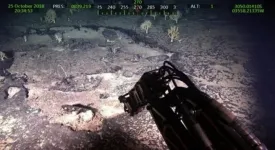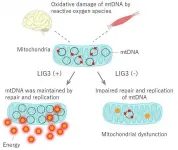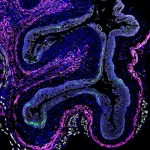(Press-News.org) The abundant biological and mineral diversity of the Rio Grande Rise, a seamount in the depths of the Atlantic Ocean about 1,500 km from the coast of Brazil, is probably due to a great extent to little-known microscopic creatures.
Researchers affiliated with the University of São Paulo's Oceanographic Institute (IO-USP), collaborating with colleagues at the UK's National Oceanography Center, investigated the microorganisms inhabiting the seamount's ferromanganese crusts and concluded that bacteria and archaea are probably responsible for maintaining the abundant local life, besides being involved in the process of biomineralization that forms the metals present in the crusts.
An article published in the journal Microbial Ecology describes the study, which was funded by FAPESP and the UK's Natural Environment Research Council (NERC).
In 2014, the International Seabed Authority (ISA) awarded Brazil a 15-year grant of mineral exploitation rights to the Rio Grande Rise. Comprising 167 member states plus the European Union, the ISA is mandated under the United Nations Convention on the Law of the Sea to organize, regulate and control all mineral-related activities in the international seabed area, which corresponds to some 50% of the total area of the world's oceans.
"Very little is known about the area's biodiversity or about the impact of mining on its ecosystems," said Vivian Pellizari, a professor at IO-USP and principal investigator for the study.
The study was part of a Thematic Project supported by FAPESP. The article is one of the results of the PhD research of Natascha Menezes Bergo, currently a postdoctoral research intern at IO-USP.
"Although the process known as microbial biomineralization is well-known, oxidation and precipitation of manganese hadn't been proved, and we had no idea how it occurred in ocean areas. In July 2020, however, an article by US researchers was published in Nature showing for the first time that bacteria use manganese to convert carbon dioxide into biomass via a process called chemosynthesis," said Bergo, who participated in sample collection in 2018 on the UK research vessel RRS Discovery (read more at: agencia.fapesp.br/29617/).
"One of these bacteria, which belongs to the group Nitrospirae, was present in the DNA sequences we extracted from crust samples collected at the Rio Grande Rise. This is strong evidence that the metals there are formed not just by a geological process but also by a biological process in which microorganisms play an important part," she noted.
Besides iron and manganese, the crusts are rich in cobalt, nickel, molybdenum, niobium, platinum, titanium and tellurium, among other elements. Cobalt is essential to the production of rechargeable batteries, for example, and tellurium is a key input for the production of high-efficiency solar cells. In late 2018, Brazil applied to the ISA for an extension of its continental shelf to include the Rio Grande Rise.
In other parts of the world, similar areas that have been studied for longer with the same objectives include the Clarion-Clipperton Zone and the Takuyo-Daigo Seamount, both in the North Pacific, as well as the Tropic Seamount in the North Atlantic.
Formation
The Rio Grande Rise has an area of some 150,000 km2, three times the size of Rio de Janeiro state, and depths ranging from 800 m to 3,000 m. Formed when present-day Africa and South America separated from the supercontinent Gondwana between 146 million years ago (mya) and 100 mya, the Rise was an island that sank some 40 mya, probably owing to the weight of a volcano and its lava and the movement of tectonic plates (read more at: revistapesquisa.fapesp.br/en/revelations-from-a-submerged-archipelago-2/).
On one of their 2018 expeditions, the researchers collected from a part of the Rise samples of the ferromanganese crusts and of the coral skeletons that live on them, as well as calcarenite rock and biofilms on the crusts' surfaces. These biofilms are structured microbial communities enveloped in substances they secrete to protect themselves from threats such as lack of nutrients or potential toxins.
"Finding biofilm was an interesting surprise, as it's an indicator of an incipient biomineralization process," Bergo said. "We found the same microorganisms in our biofilm, coral, calcarenite and crust samples. The only difference was the age of the surfaces. The coral is more recent than the crusts, and the biofilm is even younger."
A total of 666,782 DNA sequences were recovered from the samples. The bacteria and archaea found by the scientists belong to groups known to be involved in the nitrogen cycle whereby ammonia is converted into nitrite and nitrate, and hence to serve as a source of energy for other microorganisms. Besides Nitrospirae, they found other prokaryotes such as the archaeon class Nitrososphaeria. Sequencing of the samples also revealed groups involved in the methane cycle such as Methylomirabilales and Deltaproteobacteria.
The results amplify scientists' understanding of the microbial diversity and potential ecological processes found on the ferromanganese crusts of the South Atlantic seabed. They will also contribute to future regulation of possible mining activities in the area of the Rio Grande Rise.
"As the crusts are removed, local circulation will probably change and this, in turn, will change the available supply of organic matter and nutrients, and hence the local microbiome and all the life associated with it," Bergo said. "Besides, the crusts grow 1 mm every 1 million years on average, so there won't be time for recolonization. It's no accident that so many studies have been published recently on how to assess and mitigate the impact of deep-sea mining."
INFORMATION:
About São Paulo Research Foundation (FAPESP)
The São Paulo Research Foundation (FAPESP) is a public institution with the mission of supporting scientific research in all fields of knowledge by awarding scholarships, fellowships and grants to investigators linked with higher education and research institutions in the State of São Paulo, Brazil. FAPESP is aware that the very best research can only be done by working with the best researchers internationally. Therefore, it has established partnerships with funding agencies, higher education, private companies, and research organizations in other countries known for the quality of their research and has been encouraging scientists funded by its grants to further develop their international collaboration. You can learn more about FAPESP at http://www.fapesp.br/en and visit FAPESP news agency at http://www.agencia.fapesp.br/en to keep updated with the latest scientific breakthroughs FAPESP helps achieve through its many programs, awards and research centers. You may also subscribe to FAPESP news agency at http://agencia.fapesp.br/subscribe.
A new analysis of antibody and B cell responses in 44 people who received either the Pfizer or Moderna mRNA SARS-CoV-2 mRNA vaccines shows that only one dose may be needed for previously infected patients who have since recovered. The study also supported that two doses is optimal to induce strong antibody and B cell responses in patients who are immunologically naïve for SARS-CoV-2, and antibodies induced by the vaccination could protect against the more infectious and deadly South African variant. The results build on an increasing body of research suggesting that people ...
Cancer is an insidious disease that, despite being around for centuries, is still very difficult to diagnose and treat. Thus, cancer has been the focus much research in the biomedical fields. Today, with research methods advancing rapidly and the base pool of researchers growing constantly, our fundamental understanding of the mechanisms of cancer formation and proliferation have increased, and new more promising treatment avenues have opened up.
In a END ...
A new study from North Carolina State University found that, on average, voters and local leaders showed greater concern about plastic and other garbage in the ocean after watching kids' presentations.
The findings, published in the journal Frontiers in Political Science, built on previous research that found educating kids about climate change was linked to an increase in concern in parents. The new findings indicate kids can have a broader impact outside of their families.
"Our lab has already established that kids can have an impact across the dinner table, and it's cool to see that they can also have an impact within ...
A pair of orbiting black holes millions of times the Sun's mass perform a hypnotic pas de deux in a new NASA visualization. The movie traces how the black holes distort and redirect light emanating from the maelstrom of hot gas - called an accretion disk - that surrounds each one.
Viewed from near the orbital plane, each accretion disk takes on a characteristic double-humped look. But as one passes in front of the other, the gravity of the foreground black hole transforms its partner into a rapidly changing sequence of arcs. These distortions play out as light from both disks navigates the tangled fabric of space and time near the black holes.
"We're seeing two supermassive black holes, a larger ...
From cancer treatment to sunlight, radiation and toxins can severely damage DNA in both harmful and healthy cells. While the body has evolved to efficiently treat and restore damaged cells, the mechanisms that allow this natural repair remain misunderstood.
In a new study, Northwestern University researchers have used cryogenic electron microscopy (cryo-EM) to visualize this process by illuminating the mysterious cycle of DNA breakage sensing and repair. The researchers believe this new information could potentially form the basis for understanding how cells respond to chemotherapy and radiation and potentially ...
The complex patterns of genetic ancestry uncovered from genomic data in health care systems can provide valuable insights into both genetic and environmental factors underlying many common and rare diseases--insights that are far more targeted and specific than those derived from traditional ethnic or racial labels like Hispanic or Black, according to a team of Mount Sinai researchers.
In a study in the journal Cell, the team reported that this information could be used to better understand and predict which populations are more susceptible to certain disorders--including cancers, asthma, diabetes, and cardiovascular disease--and to potentially develop early interventions.
"This is the first time researchers have shown how ...
Engaging in household chores may be beneficial for brain health in older adults. In a recent Baycrest study, older adults who spent more time on household chores showed greater brain size, which is a strong predictor of cognitive health.
"Scientists already know that exercise has a positive impact on the brain, but our study is the first to show that the same may be true for household chores," says Noah Koblinsky, lead author of the study, Exercise Physiologist and Project Coordinator at Baycrest's Rotman Research Institute (RRI). "Understanding how different forms ...
LOS ANGELES (April 15, 2021) -- Researchers have discovered a new way to transform the tissues surrounding prostate tumors to help the body's immune cells fight the cancer. The discovery, made in human and mouse cells and in laboratory mice, could lead to improvements in immunotherapy treatments for prostate cancer, the second most common cancer in men in the US.
Using a technique called epigenetic reprogramming, investigators altered the tumor and tumor microenvironment by inhibiting expression of a protein known as enhancer of zeste homolog2, or EZH2, which is found at high levels in prostate cancer. This protein ...
DNA ligase proteins, which facilitate the formation of bonds between separate strands of DNA, play critical roles in the replication and maintenance of DNA. The human genome encodes three different DNA ligase proteins, but only one of those proteins--DNA ligase III (LIG3)--is expressed in mitochondria. LIG3 is therefore crucial for mitochondrial health, and inactivation of the homologous protein in mice causes profound mitochondrial dysfunction and early embryonic mortality. In an article recently published in the peer-reviewed journal Brain, a team of European and Japanese scientists, led by Dr. Mariko Taniguchi-Ikeda from Fujita Health University Hospital, describes a set of seven patients with a novel ...
Infection with parasitic intestinal worms (helminths) can apparently cause sexually transmitted viral in-fections to be much more severe elsewhere in the body. This is shown by a study led by the Universities of Cape Town and Bonn. According to the study, helminth-infected mice developed significantly more severe symptoms after infection with a genital herpes viruses (Herpes Simplex Virus). The researchers suspect that these results can also be transferred to humans. The results have now appeared in the journal Cell Host & Microbe.
In sub-Saharan Africa, both worm infections and sexually transmitted viral diseases are extremely com-mon. These viral infections are also often particularly severe. It is possible that these findings ...




